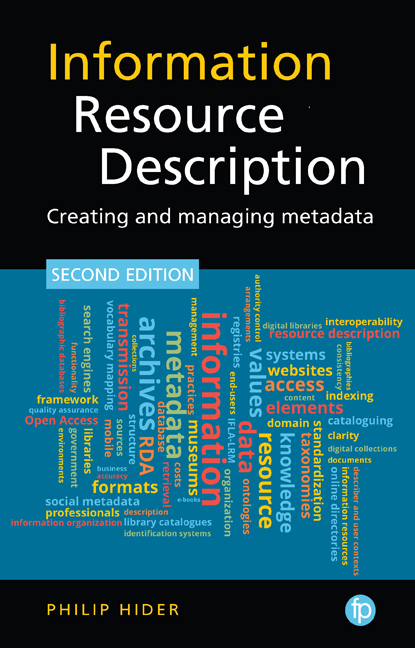Book contents
- Frontmatter
- Dedication
- Contents
- List of figures and tables
- Preface to the First Edition
- Preface to the Second Edition
- List of abbreviations
- 1 Definitions and scope
- 2 Information resource attributes
- 3 Tools and systems
- 4 Metadata sources
- 5 Metadata quality
- 6 Sharing metadata
- 7 Metadata standards
- 8 Vocabularies
- 9 The future of metadata
- Further reading
- List of metadata standards
- Index
- Frontmatter
- Dedication
- Contents
- List of figures and tables
- Preface to the First Edition
- Preface to the Second Edition
- List of abbreviations
- 1 Definitions and scope
- 2 Information resource attributes
- 3 Tools and systems
- 4 Metadata sources
- 5 Metadata quality
- 6 Sharing metadata
- 7 Metadata standards
- 8 Vocabularies
- 9 The future of metadata
- Further reading
- List of metadata standards
- Index
Summary
Introduction
We have talked previously about the purpose of different elements of resource description. In this chapter we discuss what makes for effective metadata, as not all metadata fulfils its various functions equally well. There are several aspects to metadata quality, all of which the metadata specialist, in particular, needs to bear in mind. They likewise need to consider both the elements represented and the values of these elements.
We shall start by revisiting our earlier discussions about how some elements may be more functional than others in addressing users' information needs. We shall also consider the importance of comprehensiveness, whereby fuller descriptions, with more elements, address users' needs more thoroughly. Moving on to values, we shall discuss how their accuracy and clarity affect quality, and then spend some time on an aspect of great importance at both element and value levels, namely, consistency. All or some of these five aspects of metadata quality are commonly cited by managers and researchers as key evaluation criteria. For instance, accuracy, consistency and ‘completeness’ were found to be the three most important criteria for digital collection managers according to Park and Tosaka's study (2010). Similar ‘dimensions’ of metadata quality have also been discussed by Theimer (2013, 247), who observes that there is no general agreement on how ‘quality’ should be defined, nor how it is best measured, but that ‘through effective understanding, assessment, communication of metadata quality, all organizations have the opportunity, maybe an obligation, to create happier, even delighted, users’.
Finally, we shall look at mechanisms for improving the quality of metadata, such as vocabulary control, and for assuring quality, and will end our discussion by considering the costs that effective metadata incurs.
Functionality
Numerous metadata elements could be recorded in the description of an information resource. As we have already noted, their utility depends on the information context: users' needs, users' behaviour, the retrieval system and so on. Since it is not feasible to include all possible elements in a description, those that are included should be the most supportive of the functional requirements. Determining exactly which elements these are is no easy task, and inevitably involves a degree of guesswork (we cannot be sure of future use), but careful study of the information context usually provides the metadata specialist with plenty of pointers.
- Type
- Chapter
- Information
- Information Resource DescriptionCreating and Managing Metadata, pp. 93 - 110Publisher: FacetPrint publication year: 2018



